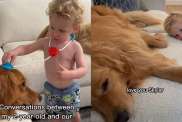
Not quite seven years ago, I was on my way to New York for the annual festivities surrounding the Westminster Kennel Club dog show. I went every year, but this trip was special: I would be picking up my first puppy ever.
We had gotten our first Cavalier King Charles Spaniel, a three-year-old sweetie named Bella the previous year. As so often happens, we discovered that one was not enough and soon began searching for a puppy. Bella’s breeder was not expecting a litter for a while so I contacted a well-respected Irish breeder. She told me she had a very cute tricolor pup who’d be old enough to ship right about the time I’d be going to New York.
Loaded with Irish charm
The day soon arrived and after a nightmarish experience trying to find Aer Lingus cargo and customs, I took custody of two puppies (the other was for a fellow Cavalier fancier). In the cab on the way back to the hotel, one settled quietly into my lap. The other explored every inch of the back seat, tried to meet the cabby, and kept running over to give me kisses. That was Darcy.
She was a delight. When my husband, Jerry, picked us up at LAX and that little head popped out of the carrier, it was love at first sight. “Happy Valentine’s Day,” I told him.
With her outgoing nature and her clear interest in everyone she met, Darcy was an ambassador not just for Cavaliers but for all dogs. She considered it her bounden duty to meet and greet everyone she saw, with a hearty Irish kiss.
We rapidly gave up trying to teach her not to lick faces because people loved it and refused to participate in the training process. But that was one of the rare instances where training didn’t work.
Darcy copied Bella who, I liked to joke, had come fully loaded. She learned all the basics and then some in short order. In fact I’ve never met a dog who could match Darcy for politeness. During a taste test of liver treats for an article I was writing, a friend of ours was besieged by what must have been a dozen Cavaliers and Dalmatians. All but 10-month-old Darcy, who knew that treats come when you sit and wait your turn.
The Cavalier curse
Like every Cavalier owner, I worried she would develop mitral valve disease, the most common form of heart disease in dogs and one that hits this breed particularly hard. When she was three, I took her to a Cavalier health fair. The cardiologist we consulted turned to me with a concerned look. “She’s not a breeding dog, is she?” she asked. She told me Darcy had a grade three heart murmur.
That was okay, my husband and I told each other. Surely she would follow Bella’s example and remain asymptomatic.
We were wrong. Darcy became a classic example of how hard and fast this disease can hit Cavaliers. And so began our dance with doctors, technicians, and specialists, all of us doing whatever we could to keep her here with us.
Initially the dance was a slow one. Every year, I took her to our vet for x-rays, an echocardiogram, and an EKG. And for three years that was enough.
But on her sixth birthday, the exam showed the disease progressing, and we started her on medication. It was a trial finding the right dose, and she lost her appetite, which scared me because Darcy loved to eat.
So I tried making an appointment with the cardiologist. It was during the holidays and I couldn’t get her in until after the new year. The vet assured me she didn’t think the delay would be a problem. She was mistaken.
Dodging death
Darcy went into heart failure just a few days before her scheduled appointment, and I spent the night at the emergency clinic wondering if she would make it through. The next morning, Darcy was transported to the nearest high-tech veterinary facility.
She stayed there three nerve-wracking days, was sent home, and then–a heartbreaking two days later–was forced to return to the hospital. The veterinarians there told us she might have only months or weeks left to live.
Still, they told us not to give up hope. The cardiologist adjusted and added to Darcy’s medications. Soon she appeared to have found a winning combination of drugs for our little dog. She was back to her happy, energetic, eager-to-eat self and it was all we could do to restrict her activity without making life unutterably dull for her.
Noting Darcy’s daily progress
It was time for Darcy to learn some new tricks. These included not jumping on the furniture, not going up and down the stairs on her own, and not chasing her toys down the hall. We got a set of steps for the furniture and taught the dogs to use them. We put a gate at the top of the stairs and bought a child’s wagon so Darcy wouldn’t miss out on walks. She’d ride in it standing up, surveying her domain. I’d toss her toys a couple of inches, laughing when she gleefully pounced on it.
She also became an internet personality. To help cope with his anxiety, my husband started a blog about Darcy’s progress, called Darcy’s Daily. Written in her voice, it detailed typical days, the ups and downs of her medications, visits to her cardiologist Dr. Barrett, fun times with the neighbors, our obsessive worrying over her, and her own blithe acceptance of the way things were.
“Dad says I’m here to teach him things,” Darcy “wrote” one day. “I’m sure one of those things is trust.” Her blog drew a small but devoted following, and her appearance in my MSNBC pet health column elicited more than a thousand clicks on the page with her picture, a record for the column.
Ruled by routine
At this point, we were bringing Darcy in to see Dr. Barrett about once a month, fearful we might miss some sign she was worsening. At home, routine ruled. Meals and medications were strictly scheduled. We set my PDA to alert me every time medications were due. Because of the diuretics, which increased thirst and urination, we took Darcy out to potty every two to four hours and refilled her water dishes frequently throughout the day.
Luckily, both of us work at home for the most part–me as a freelance writer and Jerry as a computer technician. And carrying 16-pound Darcy up and down the stairs numerous times a day meant I didn’t need to waste time at the gym.
For a few months Darcy did well. But in late May it became clear she was losing energy. She made no more attempts to trot or run to the grass. She moved sedately, speeding up only if she spotted one of her favorite neighbors.
But her appetite continued to be excellent. That was good, because she was getting seven medications two and three times a day, all mixed into her meals or given with treats. We’d cut a slit in a blueberry, strawberry, or the back of a tangerine slice, and insert a pill. We had other medications compounded into chicken- and fruit-flavored liquids, which we squirted on her food. She always licked her bowl clean.
Heart too big for her body
We don’t know what finally tipped her over the edge. It could have been June’s heat wave or the increased diuretic dose she needed to clear the fluid from her lungs. Or maybe her heart simply grew too big or got too tired to go on. Dr. Barrett hospitalized her and put her on oxygen, but it didn’t seem to help. Her electrolyte levels fell life-threateningly low. The vets could fix one or the other, but not both.
We said goodbye to Darcy on June 27. She was only six and a half years old and she’d given us everything she had.
My husband and I consoled each other by deciding her larger-than-life personality was meant to be shared. We started the Darcy Fund, to research causes and cures for the heart disease that cut short her generous life. “After all,” Jerry says, “it’s not often you get a dog like Darcy.”
–Kim Thornton was given the Dog Writer’s Association 2007 Maxwell award for this story, first published in Royal Dispatch magazine. Thornton, who lives in Lake Forest, California, contributed most of DogTime’s breed profiles, and has written several books, including The Complete Idiot’s Guide to Beagles, and The Everything Dog Health Book. She and Jerry live with two Cavaliers and a parrot, and have just adopted another Cavalier puppy.









